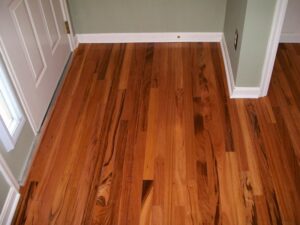Have you ever looked at your floor and thought, “How do I keep this looking good for years?” If you have, you’re not alone. Floors go through a lot every day. They handle heavy foot traffic, spills, scratches, and even sunlight. That’s why more people are choosing resilient flooring. It looks good, feels comfortable, and lasts a long time if properly cared for.
This guide will walk you through simple and effective ways to clean and maintain your resilient flooring so it keeps looking great year after year. Whether you have resilient tile flooring or resilient sheet flooring or just want to better understand the meaning of resilient flooring and its upkeep, this guide has you covered from start to finish.
What Is Resilient Flooring and Why Choose It?
Before we talk about cleaning, it helps to understand what resilient flooring really is. So, what is resilient flooring meaning? It refers to any floor that’s firm but also has a slight “give” or bounce to it. Unlike hard flooring like stone, concrete, porcelain tile, or hardwood, resilient materials can return to their original shape after pressure. This resilience provides underfoot comfort and makes the flooring easier to maintain.
Common types include luxury vinyl tile (LVT), sheet vinyl, cork flooring, rubber flooring, linoleum made from natural materials like linseed oil and wood flour, and vinyl composition tile (VCT). These materials offer water resistance, durability, and a range of design options to suit various environments.
Resilient Tile vs. Sheet Flooring: What’s the Difference?
There are two main formats when it comes to resilient flooring: resilient tile flooring and resilient sheet flooring.
Tile flooring, such as luxury vinyl tile and vinyl composition tile, comes in square or rectangular pieces. It’s great because you can replace individual tiles if they get damaged, making maintenance easier. Tile flooring also offers versatile design options, allowing you to mix and match patterns and textures.
Resilient sheet flooring, like sheet vinyl, is a continuous roll of material installed in large sheets. This makes it a great choice for areas prone to moisture, such as bathrooms and healthcare facilities, because fewer seams reduce the chance of water seepage. Sheet vinyl is water-resistant and easy-to-maintain flooring that performs well in both commercial and residential applications.
Daily and Weekly Cleaning Tips for Resilient Flooring
Daily and weekly care keep resilient flooring looking fresh and damage-free. Sweep regularly to remove dirt and grit that can cause scratches, especially in high-traffic commercial spaces. When vacuuming, avoid machines with rotating brushes that could damage the surface.
Mop once a week using warm water and a mild cleaner formulated for resilient tile flooring. Always use a damp mop rather than a wet one, and avoid harsh chemicals or bleach that can degrade the urethane finish on luxury vinyl and other resilient floors.
How to Handle Spills on Resilient Flooring?

Spills happen, but quick cleanup helps maintain water resistance and prevents staining. Wipe up liquids immediately with a clean cloth. For sticky or stubborn messes, use a damp cloth with a gentle cleaner designed for resilient flooring. Avoid abrasive scrubbing or steam mops, as excessive heat and moisture can warp or curl the flooring material.
Sunlight and Heat: How to Protect Your Resilient Floors?
Sunlight can fade resilient flooring over time, especially in areas exposed to direct sunlight daily. Use curtains, blinds, or UV-blocking window films to protect your flooring’s aesthetic and durability.
Avoid placing space heaters or other heat sources directly on the floor, as heat can soften and damage materials like luxury vinyl and sheet vinyl. If necessary, use a thick mat or board as a buffer.
How to Spot and Fix Early Signs of Floor Damage?
Regularly inspect your floors for signs of lifting corners, loose seams, or surface scratches. Early repairs with adhesive or patch kits can prevent more extensive damage. For resilient tile flooring, replacing individual tiles is often a simple and cost-effective solution.
Long-Term Maintenance Tips for Resilient Flooring
Deep clean resilient flooring every six months using recommended cleaners to maintain its surface and water resistance. Avoid waxing unless specified by the manufacturer, as wax can dull floors with factory-applied urethane finishes.
When moving heavy furniture, always lift instead of dragging. Use sliders or plywood sheets to protect the flooring surface, especially on sheet vinyl or cork flooring.
Benefits of Resilient Flooring for Homes and Commercial Spaces
Resilient flooring offers many benefits, including durability, water resistance, underfoot comfort, and design versatility. It’s a popular choice for both residential applications and commercial spaces such as healthcare facilities, operating rooms, offices, and retail environments.
With proper care, resilient flooring can withstand heavy traffic and daily wear while providing an attractive, easy-to-maintain flooring solution that complements any aesthetic.
Conclusion
Resilient flooring is a great investment, but it only stays that way with regular care and smart habits. Sweep it often, mop gently, and protect it from heat and sharp objects. With the right steps, your floor will stay beautiful for years.Need help with installation or repairs? Contact Floor Guys. We’re here to make sure your floors look and perform their best. Call +971 585498158 or send an email to sale@floor-guys.com to get started.
Frequently Asked Questions
Can I place rugs on resilient flooring?
Yes, but make sure they have a non-slip backing that won’t stain. Rubber-backed rugs can sometimes cause discoloration. Choose breathable rug pads that won’t trap moisture or heat, especially in humid areas like kitchens or bathrooms.
Is resilient flooring safe for homes with small kids?
Absolutely. It’s a good choice for homes with children because it’s soft underfoot and easy to clean. Plus, it’s durable enough to handle spills, playtime, and running feet without showing too much wear.
Do I need to seal resilient flooring after installation?
Most modern resilient flooring comes with a factory-applied finish, so sealing isn’t usually necessary. However, older or specific types like linoleum might benefit from an occasional sealant to extend protection and enhance appearance.
What should I avoid using on resilient flooring?
Stay away from wax, bleach, ammonia, and strong solvents. These can break down the finish and cause fading or damage. Also, don’t use abrasive scrubbers or steel wool. Stick to pH-neutral cleaners and soft clothes.
How do I remove stains that won’t come off with regular cleaning?
For stubborn stains, use a cleaner that’s approved by your flooring manufacturer. Apply it with a soft cloth and gently rub the area. If that doesn’t work, you may need a specialty product or to call a professional for help.






